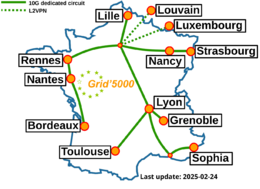Grid5000:Home
|
Grid'5000 is a precursor infrastructure of SLICES-RI, Scientific Large Scale Infrastructure for Computing/Communication Experimental Studies.
|
|
Grid'5000 is a large-scale and flexible testbed for experiment-driven research in all areas of computer science, with a focus on parallel and distributed computing, including Cloud, HPC, Big Data and AI. Key features:
Older documents:
|
Random pick of publications
Five random publications that benefited from Grid'5000 (at least 2899 overall):
- Sorina Camarasu-Pop. Computational Reproducibility. 3rd cycle. 12th SLEIGHT Science Event, Saint Etienne (FR), France. 2024. hal-04649287 view on HAL pdf
- Can Cui, Imran Ahamad Sheikh, Mostafa Sadeghi, Emmanuel Vincent. End-to-end Multichannel Speaker-Attributed ASR: Speaker Guided Decoder and Input Feature Analysis. 2023 IEEE Automatic Speech Recognition and Understanding Workshop (ASRU 2023), Dec 2023, Taipei, Taiwan. 10.1109/ASRU57964.2023.10389729. hal-04235774 view on HAL pdf
- Barbara Gendron, Gaël Guibon. Context-Aware Siamese Networks for Efficient Emotion Recognition in Conversation. 2024. hal-04532408 view on HAL pdf
- François Portier, Lionel Truquet, Ikko Yamane. Nearest Neighbor Sampling for Covariate Shift Adaptation. 2024. hal-04645530 view on HAL pdf
- Lucas Leandro Nesi. Strategies for Distributing Task-Based Applications on Heterogeneous Platforms. Distributed, Parallel, and Cluster Computing cs.DC. Université Grenoble Alpes 2020-..; Universidade Federal do Rio Grande do Sul (Porto Alegre, Brésil), 2023. English. NNT : 2023GRALM048. tel-04468314 view on HAL pdf
Latest news
![]() Cluster "larochette" is now in the default queue in Luxembourg
Cluster "larochette" is now in the default queue in Luxembourg
We are pleased to announce that the larochette[1] cluster of Luxembourg is now available in the default queue.
Larochette is a cluster composed of 7 nodes, each with 4 MI210 AMD GPUs.
The node features:
This cluster was funded by the University of Luxembourg.
[1] https://www.grid5000.fr/w/Luxembourg:Hardware#larochette
-- Grid'5000 Team 17:46, 26 August 2025 (CEST)
The first SLICES-FR School is organized from July 7th to 11th in Lyon.
This free event, co-organized with the PEPR Cloud and Networks of the Future, brings together researchers, engineers and professionals to explore advances in distributed computing, edge computing, reprogrammable networks and the IoT.
-- Grid'5000 Team 09:30, 9 July 2025 (CEST)
![]() Cluster "vianden" is now in the default queue in Luxembourg
Cluster "vianden" is now in the default queue in Luxembourg
We are pleased to announce that the vianden[1] cluster of Luxembourg is now available in the default queue.
Vianden is a cluster of a single node with 8 MI300X AMD GPUs.
The node features:
The AMD MI300X GPUs are not supported by Grid'5000 default system (Debian 11). However, one can easily unlock full GPU functionality by deploying the ubuntu2404-rocm environment:
fluxembourg$ oarsub -t exotic -t deploy -p vianden -I
fluxembourg$ kadeploy3 -m vianden-1 ubuntu2404-rocm
More information in the Exotic page.
This cluster was funded by the University of Luxembourg.
[1] https://www.grid5000.fr/w/Luxembourg:Hardware#vianden
-- Grid'5000 Team 11:30, 27 June 2025 (CEST)
![]() Cluster "hydra" is now in the default queue in Lyon
Cluster "hydra" is now in the default queue in Lyon
We are pleased to announce that the hydra[1] cluster of Lyon is now available in the default queue.
As a reminder, Hydra is a cluster composed of 4 NVIDIA Grace-Hopper servers[2].
Each node features:
Due to its bleeding-edge hardware, the usual Grid'5000 environments are not supported by default for this cluster.
(Hydra requires system environments featuring a Linux kernel >= 6.6). The default system on the hydra nodes is based on Debian 11, but **does not provide functional GPUs**. However, users may deploy the ubuntugh2404-arm64-big environment, which is similar to the official Nvidia image provided for this machine and provides GPU support.
To submit a job on this cluster, the following command may be used:
oarsub -t exotic -p hydra
This cluster is funded by INRIA and by Laboratoire de l'Informatique du Parallélisme with ENS Lyon support.
[1] Hydra is the largest of the modern constellations according to Wikipedia: https://en.wikipedia.org/wiki/Hydra_(constellation)
[2] https://developer.nvidia.com/blog/nvidia-grace-hopper-superchip-architecture-in-depth/
-- Grid'5000 Team 16:42, 12 June 2025 (CEST)
Grid'5000 sites
Current funding
INRIA |
CNRS |
UniversitiesIMT Atlantique |
Regional councilsAquitaine |




